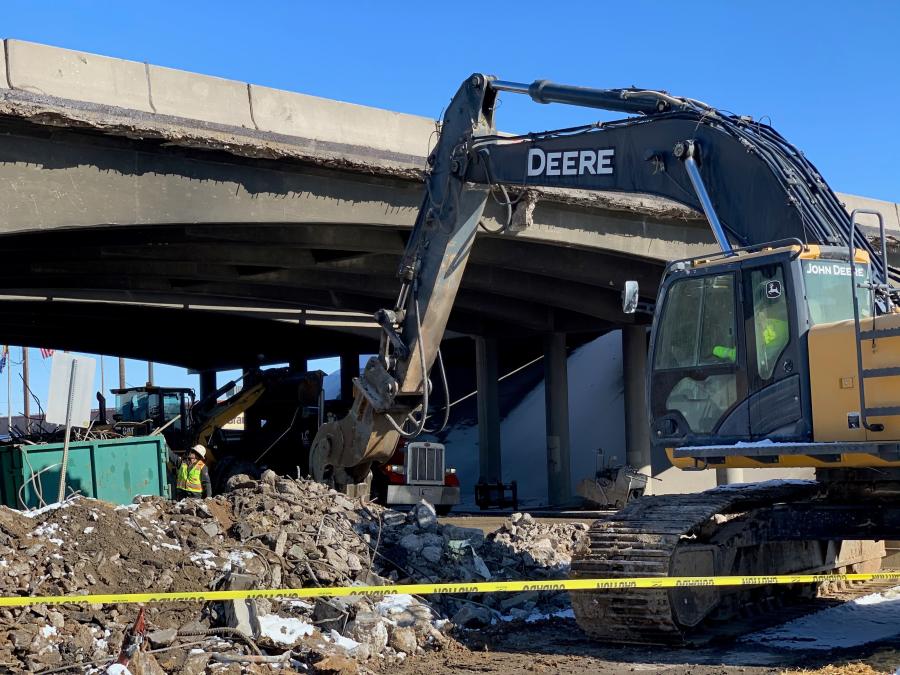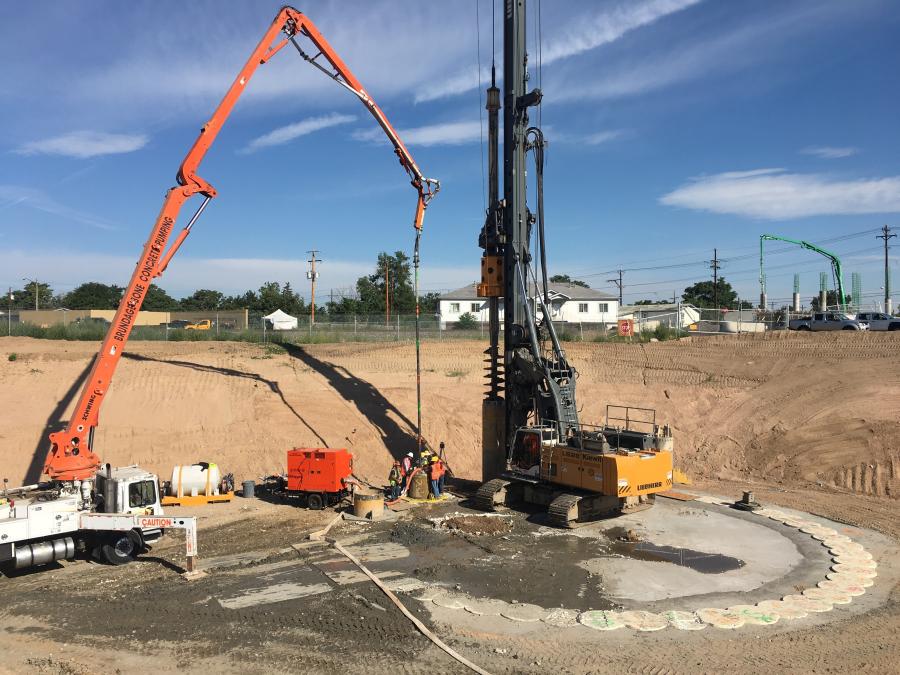Excavation work is performed under Monroe Street.
(Colorado Department of Transportation photo)
Crews continue to make progress on the Central 70 project in Denver, Colo. The $1.2 billion effort will reconstruct a 10-mi. stretch of I-70 between Brighton Boulevard and Chambers Road, along with adding one new express lane in each direction and removing an aging viaduct.
"The project has been running very well," said Stacia Sellers, Colorado Department of Transportation (CDOT) Central 70 communications manager. "We have made significant progress since we began construction in August 2018, including the excavation of up to 700,000 cubic yards of soil, construction of the I-270 flyover, construction of the new I-70 bridge over Peoria Street and construction of two bridges that will serve as the bookends of the future cover park."
Colorado is the eighth fastest growing state in the United States, with a population of more than 5.6 million as of 2017.
I-70 between I-25 and Chambers Road continues to be impacted by road congestion issues, creating traffic buildup on I-70 for up to 10 hours a day.
"This section of I-70 is also home to 1,200 businesses," said Sellers, "providing the regional connection to Denver International Airport and carrying upwards of 200,000 per day.
"In addition, I-70's aging viaduct is Colorado's second largest bridge, and is the last of 33 worst bridges in the state yet to be addressed. The band-aid fixes are beginning to fail, and the viaduct is now at the end of its useful life."
Coming to Life
Sellers noted that the team has been working on making the Central 70 Project come to life since 2003, when CDOT and Denver's Regional Transportation District began a joint study effort called the I-70 East Corridor Environmental Impact Statement.
"We have held hundreds of public meetings, both formally and informally, since then to decide which alternative to select that would benefit both commuters and the communities surrounding the project area. It has been beyond rewarding to see all our hard work come to life with a project that will have a positive effect on the state of Colorado."
Sellers said motorists are coping well during ongoing construction.
"The Central 70 Project is dedicated to minimizing traffic impacts on I-70 during the day by scheduling lane closures and interstate work at night," Sellers said. "Any long-term closures on streets adjacent to I-70 that would affect residents and/or businesses are communicated weeks in advance, and detour maps are provided so all motorists can successfully detour any road closures. Overall, thanks to our communications efforts, motorists have been able to safely navigate construction, and are aware when there are upcoming closures."
Sellers stressed that the safety of the public and crews is the number one priority for both CDOT and Central 70's contractor, Kiewit.
Safety First
"We have advanced signage in place to alert motorists when they are coming up on a work zone, we avoid doing lane closures on I-70 during the day and we work with media to communicate when there will be a new alignment on I-70, so motorists are aware ahead of time and can better maneuver the new configuration," Sellers said.
"To keep our crews safe," Sellers added, "we map out what the work zone will look like before work in an area even starts. This way, we can see if there are areas that we can make safer, and the team knows what's expected. We also have a safety team that constantly drives to different work zones to make sure crews are working safely and set up their work zone according to pre-established plans."
Once the project is complete, motorists will have trip time reliability when driving on the new express lane.
"Express lanes have proven to be successful in Colorado and help relieve congestion," said Sellers. "We will also see less congestion in the general-purpose lanes as well, because of the express lanes and wider lanes. Motorists will also have several safety improvements, including wider shoulders or in some places new shoulders where they did not exist before. Electronic lane usage signs are also being installed to alert motorists ahead of time that a lane is closed.
"We don't just focus on construction work as part of this project; we also focus on the communities affected by construction happening in their neighborhood or business center. In 2019, we spent over 900 hours in the Globeville, Elyria and Swansea neighborhoods, either attending registered neighborhood organization meetings, community office hours where our bilingual community liaison meets residents where they are to answer questions or concerns, and other meetings our project team is invited to in the community."
Challenges
According to Matt Sanman, Kiewit Meridiam Partners public information manager, challenges include building the project next to a school and an established neighborhood. Removing a viaduct while maintaining traffic flow has been another concern, along with rebuilding a highway with 200,000 vehicles per day, maintaining access to 1,200 businesses during construction and dealing with three separate railroad locations.
"Right now, we are conducting various utility relocations, reconstructing the I-70/Brighton Interchange, widening the central segment of I-70, constructing bridges that will be over the future lowered section and building out the westbound lanes of the lowered section.
"We have already constructed the new and demolished the old I-270 flyover over I-70, built the I-70 at Peoria Street Bridge and received final approval of the Union Pacific Railroad final bridge design, which is a critical path on the project. We also have traffic in its final configuration on the east segment of our project between Quebec Street and Chambers Road."
Milestones on the project include construction of the Peoria Street bridge, the demolition of the viaduct between Brighton and Colorado boulevards and switching existing I-70 traffic into the lowered section, the construction of three railroad bridges, completion of utility relocations, construction of the cover park and the completion of each segment of the project.
Approximately 2.1 million cu. yds. will be moved during construction. Kiewit has performed soil characterization samples in order to prepare and plan ahead for the excavation work and dirt moving. This will provide efficiency in handling, reducing emissions from multiple moves, as well as efficiencies in planning ahead in areas of the project that need the dirt, and being able to haul it where it's needed most.
Reconstructing the 10-mi. stretch of I-70 between Brighton Boulevard and Chambers Road involves widening the highway to the north and south sides, while traffic is maintained in the existing configuration. This will allow for traffic to move out to those widened sections, while the middle portions of the highway are reconstructed. Moving the traffic into the final configuration with one express lane added in each direction also is necessary.
Adding one new express lane in each direction requires a few extra feet of pavement, and the addition of the "smart" highway equipment that will accommodate collecting tolls.
"This extra capacity has already been added in the east segment between Quebec Street and Chambers Road," said Sanman. "Tolling will not be in place until after the project is complete, but motorists will be able to use the express lane free of tolling for the duration of the project."
Crews will begin removing the viaduct in segments in 2021. They are currently in the planning process to determine how the work will be carried out. In addition, I-70 will remain on its current alignment until the lowered section is ready for traffic. The lowered section is being built just north of the current alignment, so excavation and other work can take place without disrupting I-70 traffic.
The plans also call for a four-acre park, which is considered the cornerstone of the project.
"The park will serve as a physical and visible reconnection of the neighborhoods on the north and south sides of the interstate. We hope it has been designed in such a way that the park will become a community gathering place — one you won't even realize is above an interstate."
Key tasks remaining on the project include demolition of the I-70 viaduct, switching traffic into the lowered section, completion of the lowered section and construction of 19 bridges along the 10-mi. stretch.
A variety of heavy equipment is being used by crews, including excavators, drilling rigs, cranes, pile driving machines, pavers, pump trucks, loaders and trucks. Materials include embankment dirt material, concrete, steel, asphalt and plastic.
For the most part, the work has gone smoothly; however, there have been a couple of snags along the way.
"We worked through a few minor hiccups at the start of construction," said Sanman. "For example, we found some of the old Stapleton Airport runways that were buried, but nothing completely unexpected."
Weathering the Conditions
The elements also have been an issue.
"Weather has definitely slowed down production, considering we have been experiencing snow storms during the winter and spring seasons; however, weather has been accounted for in the overall schedule, and won't affect the completion of the project."
Sanman said a number of steps have been taken to reduce noise and dust in the area during construction.
"The project will include intermittent night work on and adjacent to I-70 between Brighton Boulevard and Chambers Road throughout construction. Night work in residential areas must follow specifications set out in a variance approved by the Denver Board of Public Health and Environment."
After-hours work must stay under 75 decibels, based on an hourly average. Work may occur from Monday through Friday from 9 p.m. to 7 a.m. and Saturday and Sunday from 5 p.m. to 8 a.m. General construction may not occur in the same residential area for more than five consecutive nights in a seven-day period.
Sound barriers are being installed near the CDOT property line in residential areas, as an additional noise reduction method. When major construction activities are scheduled where noise levels are expected to exceed the variance levels, such as bridge demolition, hotel vouchers will be offered to affected residents.
There are four air quality monitors installed adjacent to the project to monitor dust during construction. The monitors are set to send an alert to both CDOT and Kiewit if PM10 levels start to rise. This allows the teams to identify the dust-causing operation and implement additional dust mitigation measures prior to the PM10 levels exceeding regulations.
Sanman said the most time-consuming part of the work is managing the day-to-day challenges that arise from multiple disciplines under construction.
"We work closely with CDOT to come up with agreeable solutions that can be fit into the plan to keep the project on schedule and under budget.
"This project is really unprecedented in the state. It's an honor to work with such a sophisticated contractor team and CDOT, who have the community and the traveling public's best interests in mind. CEG
Cindy Riley
Birmingham, Ala., native Cindy RIley originally planned on a career in law, but during her sophomore year in college realized journalism was her true calling. A magna cum laude graduate of Samford University, Riley first worked in radio and TV. Named Best News Anchor, Best News Reporter and Best Investigative Reporter by the Associated Press, she interviewed numerous personalities, ranging from Dr. Henry Kissinger and President Bush to Michael Jordan and Captain Kangaroo.
As a print journalist, Riley has covered a variety of topics, including construction, business, health and the arts. In addition to CEG, her work has appeared in special reports for USA Today and the L.A. Times. Other publications have included New South Magazine, Portico, Thicket, Alabama Heritage, B-Metro, Business First and Birmingham Business Journal.
Read more from Cindy Riley here.
Today's top stories





















